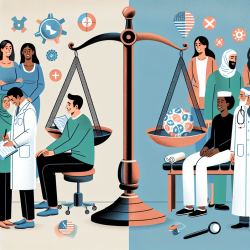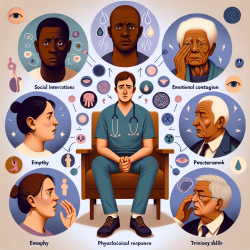Understanding Intersectionality in Health
The concept of intersectionality, as explored in the research article "Race, gender, class, and sexual orientation: intersecting axes of inequality and self-rated health in Canada," provides a nuanced understanding of health disparities. This framework considers the complex interplay between various social identities and how they collectively influence health outcomes. For practitioners, especially those involved in speech-language pathology and online therapy services like TinyEYE, integrating these insights can enhance the effectiveness of interventions and support services provided to children and their families.
Key Findings from the Research
The research utilizes data from the Canadian Community Health Survey, applying intersectionality principles such as "directionality," "simultaneity," "multiplicativity," and "multiple jeopardy" to understand health inequalities. The study reveals that individuals identifying as Aboriginal, Asian, or South Asian, those from lower socioeconomic backgrounds, and bisexual individuals report poorer self-rated health outcomes. These findings underscore the importance of considering multiple social determinants of health rather than isolating them.
Implications for Practitioners
For practitioners in speech-language pathology, understanding these intersectional dynamics is crucial. Here are some actionable insights:
- Holistic Assessment: When assessing a child's speech and language needs, consider the broader socio-cultural context, including race, gender, class, and sexual orientation influences on the family.
- Tailored Interventions: Develop interventions that are sensitive to the unique challenges faced by children from marginalized communities. For instance, cultural competence in therapy can improve engagement and outcomes.
- Advocacy and Support: Advocate for policies and practices that address systemic inequalities. This includes supporting inclusive education policies and promoting access to resources for underserved communities.
Encouraging Further Research
The study highlights the need for further research into the intersections of race, gender, class, and sexual orientation in health outcomes. Practitioners can contribute by:
- Participating in Research: Engage in or support research initiatives that explore intersectional health disparities, particularly in pediatric populations.
- Data Collection: Collect and analyze data in practice settings to identify trends and disparities in speech and language development among diverse groups.
- Collaboration: Work with researchers, policymakers, and community organizations to develop comprehensive strategies that address health inequities.
Conclusion
By integrating intersectionality into practice, speech-language pathologists and other health practitioners can better address the complex needs of children and families. This approach not only enhances the quality of care but also contributes to reducing health disparities. To delve deeper into the research findings, practitioners are encouraged to explore the original study.
To read the original research paper, please follow this link: Race, gender, class, and sexual orientation: intersecting axes of inequality and self-rated health in Canada.










